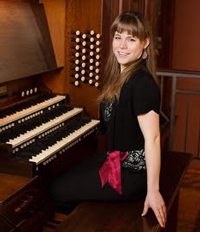by Timothy Robson

Emerson opened her program with J.S. Bach’s Prelude and Fugue in G, BWV 541. She chose a brisk tempo and a middle-of-the-road style of articulation for its manual flourishes and jolly fugue theme that worked well on the mid–20th century Holtkamp organ.
Next came two contrasting movements from Robert Schumann’s Six Fugues on BACH, based on the German notes that spell Bach’s name, and written for the Pedalflügel, a grand piano with an organ-style pedal board. In No. 1, her performance was dignified, beginning with basic foundation stops and gradually building to a climax. The piece ended as it began. As admirable as Emerson’s performance was, the music needed more flexibility of phrasing and rhythm to emphasize its vocal quality. The scherzo-like No. 6 was charming, and the organist managed its highly-articulated theme and tricky counterpoint with ease.
Jean Langlais’ “Thème et variations” is part of a tribute to Italian Baroque composer Girolamo Frescobaldi. The theme is chorale-like, but written in Langlais’ distinctive style of altered, sometimes astringent modal harmonies. Several variations in diverse styles follow, including a duo on contrasting registrations, a variation exploiting the flute stops, and a scherzo with sparkling arpeggiated flourishes.
Langlais’ widow, Marie-Louise Langlais, was one of Emerson’s teachers and a special guest for the concert. Mme. Langlais is the leading exponent of her late husband’s works, so Emerson’s fluent performance was likely authoritative.
Mozart’s Fantasie in f, K. 608, written for a small flute organ attached to a mechanical clock, closed the first half. It is hard to imagine hearing the sharply articulated opening chords and counterpoint of this monumental work played on such a device. A gentle, melodic section fills the center of the work, ending with a fugal development of the opening themes.
Emerson tossed off the opening and closing sections easily, without emphasizing the drama of the work. She registered the central section imaginatively with dialogue between the gallery organ and the smaller chancel organ, but her very brisk tempo did not give much opportunity for the music’s lyricism to expand.
The second half of the program featured excerpts from major works, beginning with the opening movement of Charles-Marie Widor’s Symphony No. 6, a set of variations on a majestic march-like chorale in which technical brilliance trumps all else. Emerson’s performance was thrilling from beginning to end.
The Cathedral’s organ is particularly suited for French Romantic music, and with its impressionist harmonies and lush string sounds, Maurice’s Duruflé’s “Sicilienne” from the Suite, Op. 5, sounded splendid. A memorable passage toward the end places the melody in the pedal on the mysterious, reedy voix humaine stop against undulating chords in the hands. This was one of the best performances on the program.
Emerson also gave an astonishing reading of Louis Vierne’s Naïades (“Water nymphs”) from his Pièces de fantaisie, Op. 55. An unending stream of sixteenth notes on soft flute registers in counterpoint with a gentle melody on string stops, the piece is unrelentingly transparent. Any flaw is immediately audible. Had the organist played nothing else but Naïades, it would still have been worth attending the concert.
Emerson ended the program with the craggy Prelude from Marcel Dupré’s Symphony II. Here, Dupré’s music is at its most jagged and dissonant — surprising in its modernism, and episodic, with many short, fragmented themes assembled, developed, and reassembled. Emerson gave it an impressive reading — an aggressive closing to a program of large works.
Emerson’s encore was a short, welcome one: Johannes Brahms’s Chorale Prelude on Herzlich tut mich erfreuen, played on soft foundation stops, with singing tone and flexible phrasing.
Published on ClevelandClassical.com November 21, 2016.
Click here for a printable copy of this article



